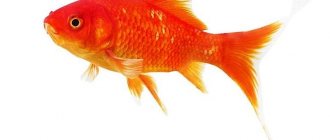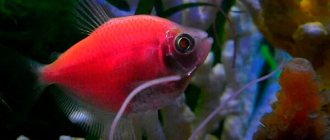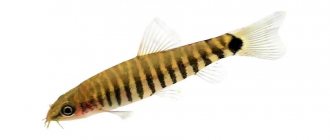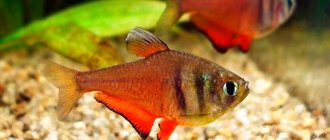Grunting gourami (Trichopsis vittata) Cuvier, 1831.
The labyrinth fish, named for its ability to make grumbling sounds similar to the croaking of a frog.
Synonyms
Russian: Latin: Osphromenus vittatus (Cuvier, 1831), Ctenops vittatus (Cuvier, 1831), Trichopus striatus (Bleeker, 1850), Trichopsis harrisi (Fowler, 1934)
Etymology
Trichopsis: From Ancient Greek (thríx), meaning "hair", and (ópsis), meaning "aspect, appearance", presumably in reference to the elongated thread-like fins most pronounced in males. vittata: From Latin (vittatus), meaning "striped".
Order: Creepers (Anabantiformes) Family: Macropods or Guramiaceae (Osphronemidae) Genus: Trichopsis (Trichopsis)
Range and Habitat
Southeast Asia: Thailand-Vietnam and the islands of Sumatra, Borneo and Java. Distributed throughout the world through the aquarium trade.
Grunting gourami (Trichopsis vittata) distribution areas, Asia
It is now found throughout much of Indochina, including the lower Mekong River basin in Laos, Cambodia, Vietnam, southern Thailand, the lower Salween basin in Myanmar, peninsular Malaysia and Singapore. Records from the Greater Sunda Islands of Borneo, Sumatra and Java may refer to individual species and require study.
Grunting gourami (T. vittata) habitats Lake Tasik Bera in Pahang
Grunting gourami (T. vittata) habitat, Mersing Malaysia
Wild populations have been established in several countries, including the Philippines, India and the USA.
Grunting gourami (T. vittata) habitats, biotope 1
Grunting gourami (T. vittata) habitats, biotope 2
Found in all types of standing and slow-moving bodies of water, including swampy forests, peat bogs, floodplains and tributaries, irrigation canals, rice fields and roadside ditches. Prefers calm and stagnant environments with dense thickets of aquatic or riparian vegetation.
Description
The body is elongated, high, slightly flattened at the sides. The mouth is small, slightly pointed upward, the eyes are large. The caudal fin is round, wide, pointed in the middle. The anal fin is long and large, the ventral fins are also long and thread-like.
Grunting gourami (T. vittata) male, appearance, description
Color varies from gold and brown to green and bluish. There are 3-4 dark stripes along the body. The middle fins have an iridescent blue color on the edges. The iris of the eye is bright blue or purple.
Grunting gourami (T. vittata) female, appearance, description
There are individuals with red, blue and purple fins, on which there are spots of a red or green hue.
Size:
Maximum standard length 60 - 70 mm.
Behavior and Compatibility
They are fairly shy, peaceful fish that do well in most aquarium communities and do not cause problems with other tank mates. Males can be quite territorial and aggressive with each other during the breeding season, but will not cause harm given the large enough aquarium, and usually coexist comfortably.
Grunting gourami (T. vittata) males sparring, behavior and compatibility
Should not be kept with large, aggressive fish, but are compatible with other small, peaceful fish, as well as other gouramis. They are very sensitive to noise and the aquarium should be in a quiet place. They should not be kept with small shrimp, which they will mistake for food.
Grunting gourami (T. vittata) pair, aquarium biotope
They can be kept in pairs or groups, in which case you will see interesting behavioral interactions.
Feeding
Trichopsis are predators; they do not spoil living plants, but snails and shrimp can suffer from them. They are generally unpretentious in feeding. The main thing is that the food fits into their small mouth. You can feed them with both complete dry food - preferably flakes - and live food - small bloodworms, coretra, tubifex - even dwarf grumbling gouramis eat this food without any problems. And frozen cyclops and daphnia are even more suitable for feeding. The main thing is not to overfeed and make the diet as varied as possible.
Aquarium
The aquarium with dimensions 60 * 30 cm is suitable for one couple. The group will need more space.
An aquarium with dense vegetation that will form thickets, while leaving free space for swimming. Adding some floating plants and driftwood (roots or branches) to diffuse the light entering the aquarium also gives a more natural feel. Driftwood can also be used to house other plants, such as Thailand fern or various types of mosses that can be attached to it.
Grunting gourami (T. vittata) aquarium biotope, Mekong River, Vietnam
Keep the aquarium well covered and do not fill it to the top, as these fish require access to air. While the presence of a lid is necessary to keep the air at the surface warm, its absence can lead to colds.
Water parameters:
Temperature: 22 - 28° C pH: 6.0 - 8.0 Hardness: 5 - 19° dGH
Light aeration with filtration is required, they do not like currents, and they will not build a nest even with slight water fluctuations. Water should be changed no more often than twice a month by approximately 10-20%.
Fish are prone to oodinosis, which can hardly be cured if they are kept in too acidic and soft water.
Conditions for keeping a grumbling gourami
Peaceful, rather active fish, during periods of excitement, especially males, make grumbling sounds. It can be kept in a general aquarium, which is preferably closed at the top so that there is warm air above the surface of the water, because otherwise, the fish will catch cold air and may catch a cold.
The aquarium with the grumbling gourami is densely planted with various plants, leaving room for free swimming. Since the fish does not like bright lighting, floating plants are placed on the surface, which not only diffuse the light, but also serve as material for building a nest. The fish will also be grateful for the presence of snags and various shelters. The tannins released by driftwood will not only improve the health of the fish, but will also make the water look like water from their habitat.
As with any other fish, high concentrations of poisons are unacceptable for gourami: ammonia, nitrites and nitrates . Every conscientious aquarist should always have a set of drop tests on hand, at least for nitrate and phosphate. Fortunately, they have now become inexpensive, there are no problems with their assortment and acquisition. For example, we can with a clear conscience recommend you the cool UHE drop tests, , but they are sold only online. In stores in your city - offline, you can find inexpensive Vladox tests . Friends, watch out for nitrogen compounds, keep them in check and everything will be fine for you and your pets.
Gourami have one peculiarity - they love “old water” with a soft, slightly acidic environment, i.e. with a pH of 6-7 degrees. This is understandable, because their biotope is muddy, silted rice fields, puddles and ditches. And this is the moment we want to chew on for beginners.
When a beginner reads “old water,” he thinks, “Aha, that means you don’t have to change the water in the aquarium with it for a long time.” Even some aquarium websites say: “Guramis love old water. Therefore, do water changes less frequently.”
However, this is not quite true. The meaning of the phrase “old water” is somewhat different. It means a well-ripened biological environment in which all links of the biocenosis work as a single, well-coordinated mechanism. Therefore, on the contrary, you can easily change the water as much as you like. This will not harm the gourami. It’s simply best to keep them right away in an established aquarium, where the nitrogen cycle works like a Swiss clock, where there is a lot of vigorous and varied grass, where the whole bunch and all hydrobionts are happy.
Let’s also say a few words about the concept of “black water”, which gouramis also love. You've all seen biotope aquariums with dark brown water. This is exactly what it is - “black water”. In professional biotope aquariums, this effect is most often achieved naturally - due to the abundance of driftwood and all kinds of foliage in the aquarium. They are the ones who release tannins abundantly into the aquarium, which tint the water.
It is not necessary to shove logs and sticks into an amateur aquarium with gourami. For a beginner, this can only cause problems with the nitrogen cycle. Instead, you can use, for example, a conditioner such as Tetra Thorumin , which is essentially a peat extract. It contains tannins and humic acids, as well as a certain amount of macro and micro elements, and other useful things for both fish and plants.
We would like to draw the attention of beginners that Tetra Torumin ibn peat extract does not have to be used according to the instructions. On the contrary, it is best to use it little by little, as a treat, for example, adding it after a water change. Those. It is not necessary to pour the extract until the stable color of childish surprise. This is due to the fact that peat is a good thing, but it still burdens the ecosystem. It is best used in a stable aquarium, in which everything is super nitrogen-cycled. And if this is the case, then we assure you that the addition of tannins and humins will please your plants, as well as soft-water slaves, which are the heroes of this video - gourami. And also, for example: angelfish, neons, cockerels.
Sexual Dimorphism
Males are larger, slimmer and brighter than females; the rays of their anal, caudal and dorsal fins are noticeably more elongated.
Grunting gourami (T. vittata) male, appearance, difference
Grunting gourami (T. vittata) female, appearance, difference
Females reach sexual maturity by six months of age, males mature later, by 1-2 years.
Breeding
For successful reproduction, you will need a spawning tank of 15 liters or more, possibly without soil, the water level in which will be about 10-15 cm. To build a nest, the male needs small-leaved floating plants, for example, water fern or riccia. The sight glass closes so as not to disturb the fish.
A male and a pair of females are kept separately for two weeks before spawning. The nest is built by the male, constructing it from bubbles under the leaves of floating plants.
Grunting gourami (T. vittata) male, caring for offspring, breeding
Depending on the age, the female lays up to 200 eggs, after which she lays eggs, and the male takes care of the eggs.
Incubation lasts up to 3 days, and after another 2 days the fry begin to swim and feed on their own. At this stage, the male leaves, and the water level in the spawning tank drops to 5, maximum 10 cm until the fry develop a labyrinth. For the first few days they require ciliates and rotifers as the brine shrimp nauplii grow.
Grunting gourami (Trichopsis vittata) juvenile, breeding
When favorable conditions are created, the life expectancy in an aquarium is about 3-5 years.
There is a piece of the ocean in the house
Not many people are lucky enough to scuba dive to the seabed and hide and watch the flickering of tropical fish. Their multicolored colors are compared to a living rainbow, and underwater plants and corals only add color to this unreal show of wildlife. And let it not be possible to take this magnificence home, and let photographs and impressions fade over time. But you can install an aquarium in your house and breed guppies you know from childhood in it, or take aim at tropical exotics, for example, a grumbling gourami.
An aquarium is considered a closed ecosystem with its own laws and preferences. Therefore, it is very important not only to create comfortable conditions for the inhabitants, but also to select fish so that they live together and do not harm each other.
kissing gourami - care and maintenance in the aquarium
Notes
This species can be distinguished from its relatives by its relatively larger size of adult fish, more elongated filiform rays of the anal fin reaching almost to the tip of the caudal fin, having 3 (vs. 1-2) dark stripes on the sides of the body and the presence (vs. absence) of a dark spot above pectoral fin. Wild populations vary in color to some extent, and it is possible that there is hidden diversity within the genus.
The common name comes from the ability of members of the genus to produce audible sounds using a specialized thoracic mechanism that is unique to the family Osphronemidae. This structure consists of modified pectoral fin tendons and muscles that are stretched and plucked by the basal portion of the anterior fin rays like guitar strings. The pectoral fins beat alternately, each of which is capable of generating short or long sound pulses. These sounds are produced by both sexes, primarily during mating interactions, and they vary in timing between species. Research shows that Trichopsis species are able to resolve conflicts without physically harming each other by assessing factors such as body mass and body length, which are conveyed by both visual and acoustic "croaking" signals. During courtship, the female makes "purring" sounds to initiate spawning, and they are the only fish that do this.
Like others in the suborder Anabantoidei, this species possesses an accessory respiratory organ known as the labyrinth, which allows the fish to breathe atmospheric air. Consisting of paired suprabronchial organs formed by expansion of the epibranchial (upper) portion of the first branchial arch and located in a chamber above the gills, it contains many highly vascularized* folded flaps of skin that function as a large respiratory surface. Its structure varies in complexity between species and tends to be more developed in those living in harsher environments.
*Vascularization is the provision of blood vessels and, therefore, blood to organs, areas and parts of the body.
Diseases
Trichopsis diseases are characteristic of all labyrinths - first of all, this is oodiniumosis, it manifests itself in the form of a mucous coating on the body and tiny golden rashes, and is treated by adding the drug Sera omnipur to the aquarium water. Trichopsis can also suffer from ichthyophthyriosis, caused by parasitic ciliates; often the fish become ill soon after purchase; this disease is treated with the drug Sera costapur. Well, the scourge of labyrinths is mycobacteriosis, characterized by ruffled scales, dropsy, exophthalmos... in the initial stage, this dangerous and contagious, but slow-onset infection can be defeated with the drug Sera bactopur direkt.
© Aqua Logo Alexandra Chebotaev
Fields marked with * are required.











